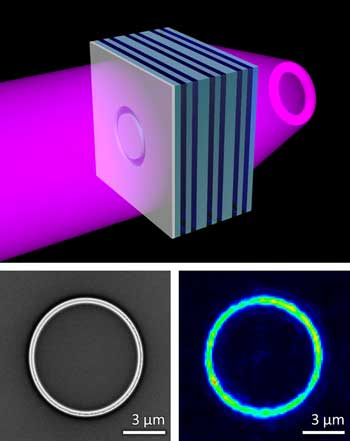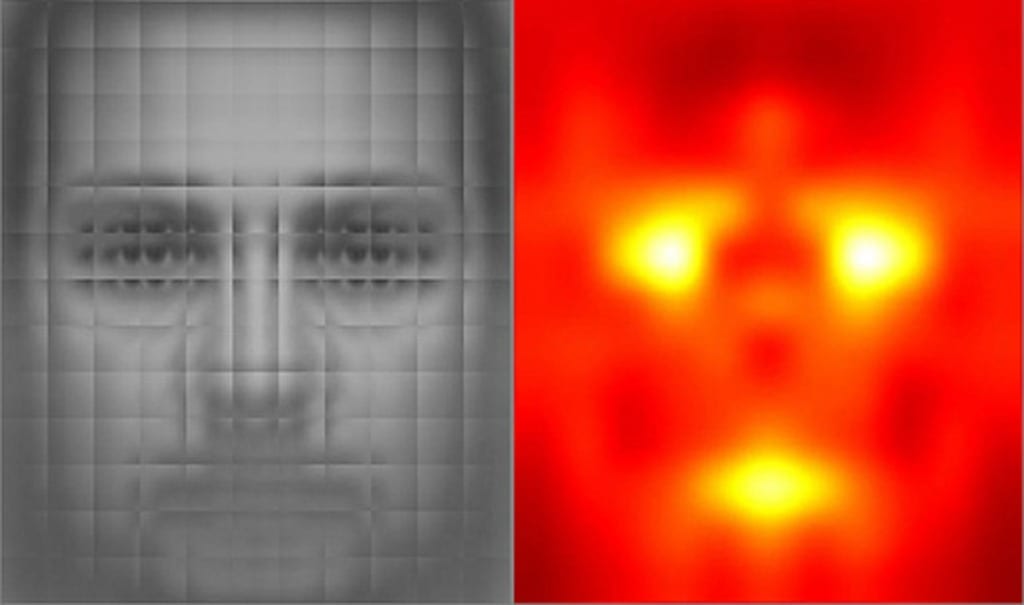
A myriad of applications, including photochemistry, fluorescence microscopy and semiconductor manufacturing
For the first time, scientists working at the National Institute of Standards and Technology (NIST) have demonstrated a new type of lens that bends and focuses ultraviolet (UV) light in such an unusual way that it can create ghostly, 3D images of objects that float in free space. The easy-to-build lens could lead to improved photolithography, nanoscale manipulation and manufacturing, and even high-resolution three-dimensional imaging, as well as a number of as-yet-unimagined applications in a diverse range of fields.
“Conventional lenses only capture two dimensions of a three-dimensional object,” says one of the paper’s co-authors, NIST’s Ting Xu. “Our flat lens is able to project three-dimensional images of three-dimensional objects that correspond one-to-one with the imaged object.”
An article published in the journal Nature* explains that the new lens is formed from a flat slab of metamaterial with special characteristics that cause light to flow backward—a counterintuitive situation in which waves and energy travel in opposite directions, creating a negative refractive index.
Naturally occurring materials such as air or water have a positive refractive index. You can see this when you put a straw into a glass of water and look at it from the side. The straw appears bent and broken as a result of the change in index of refraction between air, which has an index of 1, and water, which has an index of about 1.33. Because the refractive indices are both positive, the portion of the straw immersed in the water appears bent forward with respect to the portion in air.
The negative refractive index of metamaterials causes light entering or exiting the material to bend in a direction opposite what would occur in almost all other materials. For instance, if we looked at our straw placed in a glass filled with a negative-index material, the immersed portion would appear to bend backward, completely unlike the way we’re used to light behaving.
In 1967, Russian physicist Victor Veselago described how a material with both negative electric permittivity and negative magnetic permeability would have a negative index of refraction. (Permittivity is a measure of a material’s response to an applied electric field, while permeability is a measure of the material’s response to an applied magnetic field.)
Veselago reasoned that a material with a refractive index of -1 could be used to make a lens that is flat, as opposed to traditional refractive lenses, which are curved. A flat lens with a refractive index of -1 could be used to directly image three-dimensional objects, projecting a three-dimensional replica into free space.
A negative-index flat lens like this has also been predicted to enable the transfer of image details substantially smaller than the wavelength of light and create higher-resolution images than are possible with lenses made of positive-index materials such as glass.
It took over 30 years from Veselago’s prediction for scientists to create a negative-index material in the form of metamaterials, which are engineered on a subwavelength scale. For the past decade, scientists have made metamaterials that work at microwave, infrared and visible wavelengths by fabricating repeating metallic patterns on flat substrates. However, the smaller the wavelength of light scientists want to manipulate, the smaller these features need to be, which makes fabricating the structures an increasingly difficult task. Until now, making metamaterials that work in the UV has been impossible because it required making structures with features as small as 10 nanometers, or 10 billionths of a meter.
Moreover, because of limitations inherent in their design, metamaterials of this type designed for infrared and visible wavelengths have, so far, been shown to impart a negative index of refraction to light that is traveling only in a certain direction, making them hard to use for imaging and other applications that rely on refracted light.
To overcome these problems, researchers working at NIST took inspiration from a theoretical metamaterial design recently proposed by a group at the FOM Institute for Atomic and Molecular Physics in Holland. They adapted the design to work in the UV—a frequency range of particular technological interest.
According to co-authors Xu, Amit Agrawal and Henri Lezec, aside from achieving record-short wavelengths, their metamaterial lens is inherently easy to fabricate. It doesn’t rely on nanoscale patterns, but instead is a simple sandwich of alternating nanometer-thick layers of silver and titanium dioxide, the construction of which is routine. And because its unique design consists of a stack of strongly coupled waveguides sustaining backward waves, the metamaterial exhibits a negative index of refraction to incoming light regardless of its angle of travel.
This realization of a Veselago flat lens operating in the UV is the first such demonstration of a flat lens at any frequency beyond the microwave. By using other combinations of materials, it may be possible to make similarly layered metamaterials for use in other parts of the spectrum, including the visible and the infrared.
The metamaterial flat lens achieves its refractive action over a distance of about two wavelengths of UV light, about half a millionth of a meter—a focal length challenging to achieve with conventional refractive optics such as glass lenses. Furthermore, transmission through the metamaterial can be turned on and off using higher frequency light as a switch, allowing the flat lens to also act as a shutter with no moving parts.
The Latest Bing News on:
Metamaterial Flat Lens
- The 9 best flats in 2024, tested and reviewedon May 2, 2024 at 11:10 am
Executive editor Sally Kaplan's top pick is the ultra-popular Everlane Day Glove Flat, which she stands by even after years of testing countless other flats. "They wear beautifully, are super easy ...
- Best Places to Buy Contact Lenses Online for 2024on May 2, 2024 at 9:26 am
Getting contacts is now easier than ever, skip the doctor's office with the best places to buy contact lenses online. Nasha is a Managing Editor for CNET, overseeing our sleep and wellness verticals.
- Best lenses for astrophotography in 2024on April 27, 2024 at 11:14 am
If you're looking to get serious about night-sky photography, one of the best lenses for astrophotography could be a great addition to your kit. These specialist lenses are designed with large ...
- Viltrox announces AF 40mm F2.5 Z, a full-frame autofocus prime lens for Z-mounton April 25, 2024 at 7:16 am
The small, lightweight prime lens features internal focusing and EXIF communication with Nikon Z-mount cameras. (Includes sample gallery.) ...
- Contact lenses may help diagnose glaucoma, claims studyon April 24, 2024 at 9:15 am
Glaucoma effects around 70 million people worldwide and can cause irreversible loss of vision if not treated-but around half of those living with the condition are not aware of it.
- How To Repair A Flat Roofon April 22, 2024 at 6:04 pm
Flat roofs bring clean, flat lines to modern homes and are less expensive to install than shingled roofs. For all their benefits, flat roofs come with a unique set of challenges. In fact, repairs ...
- Superlenses to overcome the diffraction limiton April 22, 2024 at 2:10 am
Making a perfect lens that produces flawless images has been ... interface of a negative and a positive index medium allows a flat slab of NIM to focus all the diverging light rays from an object ...
- Best Places to Buy Replacement Prescription Lenses Online in 2024on April 19, 2024 at 3:00 am
Executive Editor David Carnoy has been a leading member of CNET's Reviews team since 2000. He covers the gamut of gadgets and is a notable reviewer of mobile accessories and portable audio ...
- The Best Micro Four Thirds Lenses for 2024on April 17, 2024 at 5:00 pm
Wide-angle lenses capture an epic, broad view of the world and are ideal for landscapes and architectural imaging. For Micro Four Thirds, look for lenses that cover angles wider than 12mm.
- The best iPhone lenses in 2024on April 17, 2024 at 7:07 am
The best iPhone lenses can improve the photographic skills of even the latest and greatest Apple smartphones. Whichever iOS device you own, the best iPhone lenses can improve your photography ...
The Latest Google Headlines on:
Metamaterial Flat Lens
[google_news title=”” keyword=”Metamaterial Flat Lens” num_posts=”10″ blurb_length=”0″ show_thumb=”left”]
The Latest Bing News on:
Flat lens
- If Medicare Covers Cataract Surgery, Why Are There Bills?on May 7, 2024 at 9:46 am
A cataract is a clouding of the naturally clear lens in the eye. Proteins in the lens break down and cause blurry or double vision, sensitivity to light, and difficulty seeing. In fact, cataracts are ...
- Best Places to Buy Replacement Prescription Lenses Online in 2024on May 6, 2024 at 1:18 pm
Need to replace your lenses but love your frames? Here are the best online places to shop at for replacement lenses. Executive Editor David Carnoy has been a leading member of CNET's Reviews team ...
- Woman blinded after getting lashes done with contact lenses inon May 1, 2024 at 7:56 am
Lillie Barrett began to experience an itchy eye after getting a set of £55 lashes fitted while wearing her contact lenses ...
- Canon cameras and lenses just got a lot cheaper thanks to these big cashback dealson May 1, 2024 at 7:25 am
Canon just dropped a mega cashback saving on a number of its full-frame mirrorless cameras and lenses at selected retailers. In the US there's $500 off the Canon EOS R5 which is available from B&H ...
- Woman left in tears after going blind for a month when getting eyelash extensions while wearing contact lenseson May 1, 2024 at 5:09 am
Lillie Barrett claims she lost sight in her eye due to a corneal ulcer which she believes she got during a lash appointment where she wore contact lenses.
- Best lenses for astrophotography in 2024on April 27, 2024 at 11:14 am
If you're looking to get serious about night-sky photography, one of the best lenses for astrophotography could be a great addition to your kit. These specialist lenses are designed with large ...
- 'The Hero and the Whore' invites us to consider the lens we bring to the Bibleon April 27, 2024 at 1:14 am
Reclaiming Healing and Liberation through the Stories of Sexual Exploitation in the Bible asks readers to shed the patriarchal lens through which most of us have read and studied the Bible.
- Superlenses to overcome the diffraction limiton April 22, 2024 at 2:10 am
Making a perfect lens that produces flawless images has been ... interface of a negative and a positive index medium allows a flat slab of NIM to focus all the diverging light rays from an object ...
- Huawei phone has a pop-out camera lens, just like a point-and-shoot cameraon April 19, 2024 at 4:35 am
The trademark feature of these devices was a retractable camera lens, where the front lens (there was only one!) would grow out of the front of the camera when you turned it on. This would give ...
- The best iPhone lenses in 2024on April 17, 2024 at 7:07 am
The best iPhone lenses can improve the photographic skills of even the latest and greatest Apple smartphones. Whichever iOS device you own, the best iPhone lenses can improve your photography ...
The Latest Google Headlines on:
Flat lens
[google_news title=”” keyword=”flat lens” num_posts=”10″ blurb_length=”0″ show_thumb=”left”]











